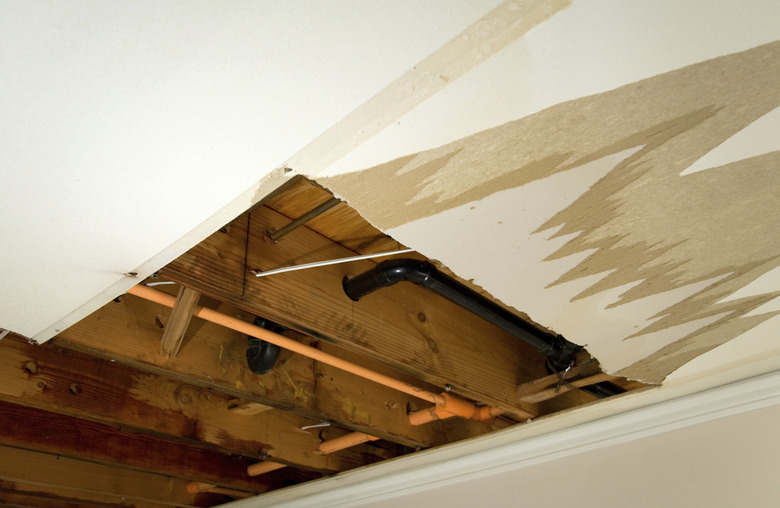What To Do With A Water Leak In The Wall
When you notice pooling water on the floor, dampness on a wall or discoloration of drywall, you're seeing the symptoms of a water leak. Systematically look for the leak, open the walls and fix it. Depending on the kind of leak, you may have to cut and replace part of a pipe. Even if you get a plumber to do this work, you will have saved money by locating the leak for him.
Find the Leak
Find the Leak
In plumbing in a wall, generally you'll be looking for a leak above the area where you have noticed the water, but the water you've found may have traveled far from the leak. Identify the walls that contain water pipes by looking where pipes go up from the basement and by checking where pipes enter the walls in bathrooms and in the kitchen. Listen carefully for dripping or hissing sounds in walls that may have water pipes. Once you have narrowed down the walls where the leak could be, you can start opening walls to check for wet pipes.
Open the Walls
Open the Walls
When you have found the possible leak location, use a drywall saw to cut out a strip of drywall about 6 inches high between two studs. Inspect the pipe through the hole. Use a flashlight for visual inspection and a paper towel to check for moisture on the pipe. You may have to cut several inspection holes on different walls to find the leak. When you have found the leak, enlarge the corresponding inspection hole or cut a new hole so you can work on the pipe.
Fix the Leak
Fix the Leak
Switch off the water. The leak may be in plastic drain pipes, copper supply pipes or galvanized iron pipes.
For plastic drain pipe, make sure the pipe on both sides of the leak is well supported with braces and clamps. Cut out the damaged piece of pipe and glue in a new piece with flanges at either end to fit over the existing pipes.
For copper pipes, cut out the leaky part of the pipe and insert a new piece of pipe with pressure fittings at both ends. Make sure you cut a length corresponding to the replacement pipe, and sand down any rough bits on the cut pipes. Slide the compression nuts and rings from the pressure fittings over the ends of the cut pipes. Insert the new pipe and tighten the nuts.
For galvanized iron pipes, get a stainless steel clamp with a rubber liner. Place the clamp around the damaged pipe and tighten the clamp's bolt.
Restore the Walls
Restore the Walls
For each hole you cut, use a drywall knife to clean out the sides of the hole and expose about half the width of each of the two studs. Cut a piece of drywall to fit the hole and fasten it in place by screwing drywall screws through each side into the studs.
Use a small drywall taping knife to apply premixed joint compound smoothly over the joints and screw holes. Embed drywall tape in the compound over the joints. Use a large drywall taping knife to layer the compound smoothly over the tape. Feather out over the drywall for about 10 inches. Sand smooth. Repaint the area.
